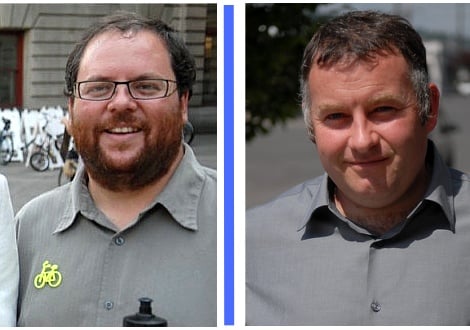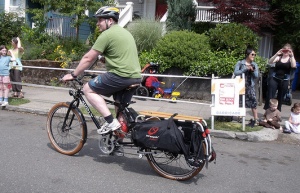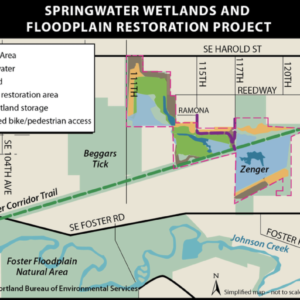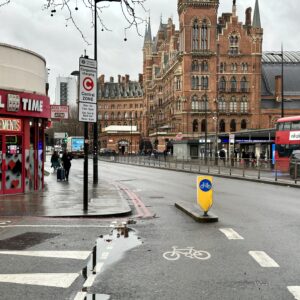
(Photos © J. Maus/BikePortland)
The exchange of ideas and best practices among transportation professionals is something that often gets overlooked. Most of our discussions are about projects, funding, culture, politics, heated policy debates and so on. But while these peer-to-peer exchanges are often hidden from the public eye (and often mocked by the media as wastes of money), they are invaluable to moving bicycling forward in Portland and beyond.
“It is super exciting to see that visit turn into something with so much impact in London.”
— Greg Raisman, PBOT
One of Portland’s strongest assets when it comes to being a leader in bicycling is its dedication to education and information-sharing. City staffers in PBOT helped launch the National Association of City Transportation Officials (NACTO), they take educational trips abroad, and they also welcome engineers and planners from other cities who want to learn from us.
Last week we saw a shining and tangible payoff to this approach when London Mayor Boris Johnson unveiled what is quite possibly the most significant and ambitious bicycle plan ever. Key elements of his plan were modeled directly on work being done here in Portland.
PBOT traffic safety specialist Greg Raisman has spent years cultivating relationships with bike planners who work for the City of London’s transportation department. Back in 2009, Raisman met Brian Deegan and Steve Cardno at the Velo City conference held in Brussels. A few months later, they both visited Raisman here in Portland (I profiled Cardno and his work in June 2009). The main focus of their trip was to learn more about our neighborhood greenways (a.k.a. bike boulevards) as they planned to make them a core element in the London bike network.

Fast forward to last week and we found out that Deegan helped write Mayor Johnson’ bike plan and, lo and behold, “Quietways” — London’s version of neighborhood greenways — figure prominently within it.
“How cool is that?!” Raisman posted to his personal Facebook page upon hearing the news.
I asked Raisman for more background on his relationship with Deegan and Cardno.
Raisman said they’ve stayed in touch over the past three years. “I’ve shared information about how our Neighborhood Greenway network is growing and evolving. We’ve bounced ideas and policies on a number of issues,” says Raisman, “There is ongoing knowledge sharing happening between us.”
When Deegan and Cardno visited in 2009, PBOT’s Neighborhood Greenway program was in its infancy. At that time we had what are now considered first-generation bike boulevards like the ones on SE Salmon and Clinton. London, on the other hand, didn’t really have much of an approach at all to residential bikeways. “They were really impressed,” recalls Raisman, “by how low-stress and convenient the residential approach can be.”
Raisman said after riding around Portland, they rolled out maps of London, pulled up Google Maps and starting thinking how a bike boulevard network could work in London. “The result was that we all thought that the concept could work, especially in the outer boroughs, but also strategically in the central city by stitching together parks and schools that have paths with residential streets,” said Raisman.
During their time in Portland, Raisman also wanted Deegan and Cardno to feel how the culture of our streets have been positively impacted by bicycling. He took them to Sunday Parkways and other events as a way to bring the concepts home.
It worked. Here are a few ways “Quietways” are described in The Mayor’s Vision for Cycling in London (note the similarities to our neighborhood greenways):
Quietways will become sites for new trees and greening, making many of them verdant corridors, even linear parks, part of the Mayor’s vision of a ‘village in the city’ where the streets are designed for people.
The Quietway network will also include new off-road greenway routes through parks and along waterways to be used for recreation and family enjoyment, building on and expanding the existing network.
Quietways will be particularly suited to new cyclists. They will stretch far into the suburbs, with both radial and orbital routes.
Where directness demands the Quietway briefly join a main road, full segregation and direct crossing points will be provided, wherever possible, on that stretch.
A cross-London network of high-quality guided Quietways will be created on low-traffic back streets and other routes so different kinds of cyclists can choose the routes which suit them.
Seeing the neighborhood greenway concept applied in the new London bike plan is a great personal thrill for Raisman (someone who, if you haven’t realized by now, believes passionately in his work).
“It is super exciting to see that visit turn into something with so much impact in London,” he says, “it is always nice when world class cities look at what is happening here and decide to bring a piece of it home.”





Thanks for reading.
BikePortland has served this community with independent community journalism since 2005. We rely on subscriptions from readers like you to survive. Your financial support is vital in keeping this valuable resource alive and well.
Please subscribe today to strengthen and expand our work.
As a Londoner I have to say my heart swells with pride at the thought of my hometown slowly turning into a bicycle paradise. It was not always so. I spent four years as a bike messenger in the mid-eighties and riding a bike in London felt more like Mogadishu than Copenhagen. The tipping point came, I believe, when Ken Livingstone (Boris Johnson’s predecessor) introduced congestion charging in the late nineties. That really opened the floodgates as thousands of car commuters switched to mass transit and bicycles. This led to an overnight reduction in congestion by over 25%. Despite being a Conservative Boris is also a populist and understands that congestion charging and dedicated bicycle highways, and ‘Quietways’, are a win win for London and it’s citizens.
can someone please give greg an alice award already? or a statue?
Did they wear the same shirt on purpose for the photos?
Greg’s an awesome guy and I’m proud to share a parking garage with him most weekdays. As a huge fan of London, I’ve been following their brilliant bike news avidly. It’s fantastic to read about this Portland connection. Thank you, Greg–and thank you, Jonathan, for this lovely piece of journalism.
Great job, Greg!
“quite possibly the most significant and ambitious bicycle plan ever”.
Perhaps for London, but I’m certain the plans implemented in Groningen and Assen (All in the Netherlands) were more dramatic. Groningen has a majority of trips by bike now, but it wasn’t that way in 1970
See: http://www.aviewfromthecyclepath.com/2009/02/how-groningen-grew-to-be-worlds-number.html
http://www.aviewfromthecyclepath.com/2009/10/before-and-after-in-groningen.html
Also, this makes me worried: “Where directness demands the Quietway briefly join a main road, full segregation and direct crossing points will be provided, WHERE POSSIBLE, on that stretch.”
It is ALWAYS possible to provide full segregation, it just takes political will. If a “greenway” or “quiteway” dumps you onto a busy street with no separation from cars for a few blocks, that won’t work for everyone. Will it really get done? As the report says, “we will do things at least adequately, or not at all.”
Overall the plan looks good on paper. Portland’s bike plan looks good on paper too, and it at least has a map. Let’s see if London has more of the political will to get it done that we do.
Thanks for exposing this hidden gem, Jonathan. Thanks for being Gregg, Gregg – you are an impressively effective catalyst for bike transportation progress. Grateful!